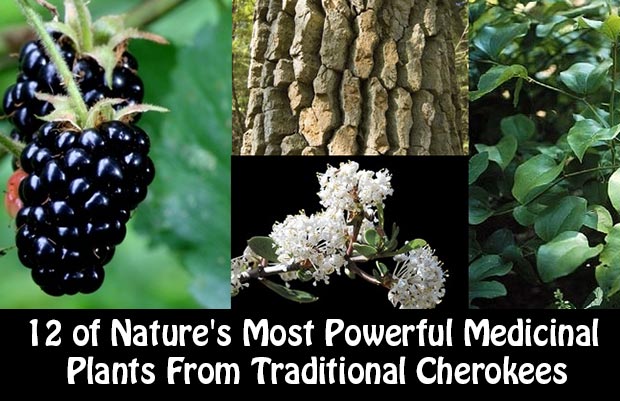12 of Nature’s Most Powerful Medicinal Plants From Traditional Cherokees
Make sure to like Living Green and Frugally on Facebook, Shop at Amazon to help support my site and explore our PINTEREST BOARDS for innovative ways you can become self-sufficient.
For centuries, the Cherokee people have cultivated a profound understanding of the natural world, relying on the healing properties of plants to treat a variety of ailments. This knowledge, passed down through generations, has created a rich tradition of herbal medicine that remains respected and utilized to this day. Here are 12 of the most powerful medicinal plants from traditional Cherokee practices, celebrated for their healing abilities and deep cultural significance.
1. Wild Ginger (Asarum canadense)
Cherokee healers often turned to wild ginger to help with digestive issues and respiratory infections. The plant’s rhizome can be prepared as a tea, acting as a powerful stimulant for the stomach and intestines, while also providing relief for nausea. Wild ginger was also believed to enhance circulation and help with heart problems.
2. Hummingbird Blossom (Buckbrush)
Known scientifically as Symphoricarpos orbiculatus, the hummingbird blossom, or buckbrush, was traditionally used to treat high blood pressure, cysts, and kidney problems. The Cherokee would make a decoction from the roots and leaves, which was then taken to alleviate these ailments. It was also considered a valuable remedy for menstrual discomforts.
3. Blackberry (Rubus allegheniensis)
This common wild fruit was more than just a food source for the Cherokee. Blackberry root was made into a tea to treat coughs, sore throats, and even upset stomachs. A strong astringent, the tea was also used to stop diarrhea and reduce inflammation. Additionally, the berries themselves were known to boost the immune system.
View this post on Instagram
4. Sumac (Rhus glabra)
Sumac was a highly versatile plant in Cherokee medicine. Every part of the plant could be utilized, from the leaves and berries to the bark. A decoction made from sumac leaves was often used to treat sore throats, while a berry tea was taken to alleviate fevers. The plant also had applications for respiratory issues and was sometimes used as a gargle for oral health.
5. Feverwort (Triosteum perfoliatum)
Also known as Wild Ipecac, feverwort was traditionally employed to induce sweating and lower fevers, especially in cases of severe colds or flu. The Cherokee would use the leaves and roots to create a medicinal tea that helped detoxify the body by promoting sweating and urination, which also aided in reducing fever.
6. Mullein (Verbascum thapsus)
Mullein was particularly valued for its effectiveness in treating respiratory conditions. The leaves and flowers were used to create teas or infusions that helped to relieve congestion, bronchitis, and asthma. The Cherokee also used mullein for its anti-inflammatory properties, applying it topically to soothe skin irritations and wounds.
7. Cattail (Typha latifolia)
A true survival plant, every part of the cattail had a use. Medicinally, the Cherokee would use the roots for a variety of purposes, including as a poultice for wounds and sores. The plant’s gel-like substance was applied to burns and insect bites for its soothing and healing properties. Cattail pollen was also used as a mild pain reliever.
8. Yarrow (Achillea millefolium)
Yarrow was an important plant for treating wounds and preventing infections. The Cherokee would apply yarrow directly to cuts and abrasions to staunch bleeding, due to its coagulant properties. They also brewed it into a tea for colds and fevers, relying on its anti-inflammatory and pain-relieving effects.
View this post on Instagram
9. Goldenseal (Hydrastis canadensis)
This powerful plant was considered a natural antibiotic by the Cherokee. Goldenseal root was commonly used to treat infections, particularly those affecting the eyes, skin, and digestive system. A wash made from goldenseal was applied to wounds to prevent infection, while teas and tinctures were taken internally to boost the immune system.
10. Dogwood (Cornus florida)
Cherokee healers utilized dogwood bark for its astringent and fever-reducing properties. A tea made from the bark was commonly given to those suffering from malaria or other fevers, and it was also used to treat headaches. The dogwood tree was considered sacred, and its bark was often harvested in a respectful manner that honored its medicinal gifts.
11. Sweet Birch (Betula lenta)
Sweet birch, with its wintergreen scent, was traditionally used by the Cherokee to treat pain and inflammation. The bark was made into a tea that could be used for everything from easing muscle pain to reducing fever. It was also used to treat digestive issues, particularly those caused by a lack of stomach acid.
12. Slippery Elm (Ulmus rubra)
Slippery elm was highly regarded for its soothing properties. The inner bark was harvested and made into a mucilaginous tea that could coat the throat and stomach, offering relief from coughs, sore throats, and digestive discomfort. It was also applied as a poultice for wounds and skin irritations, thanks to its ability to soothe and heal.
View this post on Instagram
Cultural Significance and Preservation
The Cherokee’s deep relationship with these plants reflects their broader worldview, which emphasizes living in harmony with nature. These plants were not merely seen as resources, but as sacred gifts from the Creator, to be used responsibly and with gratitude.
Today, as interest in traditional and natural remedies grows, it’s crucial to approach these practices with respect. Many of these plants are now endangered due to habitat loss and overharvesting. Efforts to protect and sustain these medicinal plants are essential, not just for preserving Cherokee heritage but for maintaining the biodiversity that supports global health.
The knowledge of Cherokee healers offers a window into a holistic approach to health, one that modern medicine is beginning to recognize for its value. By learning from these ancient practices, we can better appreciate the intricate relationship between nature and healing, ensuring that this wisdom continues to benefit future generations.
